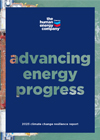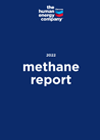environment
lowering the carbon intensity of our operations
Our strategy is straightforward - we are leveraging our strengths to safely deliver lower carbon energy to a growing world. Our capabilities, assets and customers are distinct advantages. We are building on these strengths as we aim to lead in lower carbon intensity oil, products and natural gas and to advance new products and solutions that reduce the carbon emissions of major industries.
portfolio carbon intensity
We are utilizing a portfolio carbon intensity (PCI) metric that represents the carbon intensity across the full value chain associated with bringing products to market, including from use of sold products, a type of Scope 3 emissions. Our PCI target for 2028 sets more than a 5% reduction from 2016.
chevron PCI (scope 1, 2, and 3) reduction targets for 2028:
71 g CO2e/MJ >5% reduction from 2016
A PCI calculator is available on our website for anyone to use and compare energy companies’ carbon intensities. It has recently been updated to provide increased disclosures on the assumptions around energy and emissions factors and includes a list of frequently asked questions.
approach to lowering carbon intensity of our portfolio
We aspire to achieve net zero upstream emissions (scope 1 and 2) by 2050. Accomplishing this aspiration depends on continuing progress on commercially viable technology; government policy; successful negotiations for carbon capture, utilization and storage (CCUS) and nature-based projects; availability of cost-effective, verifiable offsets in the global market; and granting of necessary permits by governing authorities. We’re taking actions to reduce the carbon intensity of our portfolio.
marginal abatement cost curve
The approach we use to drive emissions reductions in our portfolio is the marginal abatement cost curve (MACC) process. Like supply stacks, MACCs can enable a visualization of abatement opportunities, showing their relative cost and abatement potential on a similar basis.
120+
greenhouse gas abatement
projects identified
$2
billion
in carbon reduction projects by 2028
We assess reduction opportunities in the key areas of energy management; methane management, consisting of venting, fugitives and flaring reductions; CCUS; and offsets.
greenhouse gas abatement projects
We have identified over 120 GHG abatement projects to advance to execution and plan to spend more than $350 million on these projects in 2023. In 2022, we made progress on 90 projects and completed 13. We expect to spend approximately $2 billion on similar projects through 2028.
energy management
Emissions associated with our own energy use make up approximately 70% of our direct emissions (Scope 1) and indirect emissions from imported energy (Scope 2),* which is why energy management is a key focus area. Aggregated at a corporate level, such projects contribute significant reduction opportunities.
Our strategy to deploy mature, renewable power generation solutions is focused and selective. We invest in wind and solar projects that have the greatest ability to cost-efficiently lower carbon emissions. We are increasing the use of renewables in a number of our products with the aim of reducing life cycle emissions, as well as working to provide verified, low-cost, high-quality offsets to our customers around the world in an effort to help them achieve their own lower carbon goals.
Renewable Power
By sourcing more electricity from renewable sources, we are switching to a lower carbon fuel source and working toward optimizing between purchased and self-generated power. These types of efforts can reduce the direct and indirect emissions associated with our operations and lower the overall lifecycle carbon intensity of our products.
Energy Storage
Energy storage is an important component to help address intermittency with renewable generation. By combining energy storage solutions with lower carbon fuel sources, we can lower the overall carbon intensity of our products.
methane management
We believe addressing methane emissions has become a key part of being a responsible producer of oil, products and natural gas. Chevron’s ambition is to be a global leader in methane emissions performance.
Our upstream methane-intensity target is 2.0 kg CO₂e/boe by 2028, and we have reduced the methane intensity of Chevron’s oil and gas operations by more than 50% since 2016.
We're trialing emerging technology and collaborating with third parties to help find better ways to detect and measure methane emissions. We're also taking actions to improve the quality and transparency of methane emissions disclosures.
Read more about Chevron's strategy, goals and action plan to prevent, detect and reduce methane emissions in our latest Methane Report.
LNG carbon footprinting
Chevron has collaborated with Qatar Energy and Pavilion Energy to jointly develop a greenhouse gas (GHG) quantification and reporting methodology for liquified natural gas (LNG) cargoes. This LNG carbon footprinting methodology aims to deliver a cargo-specific GHG emissions profile based on the carbon footprint of the supply chain from wellhead to delivery point.
This methodology has the potential to help advance a standard for GHG product-level accounting. The framework adheres to GHG protocols and lifecycle accounting standards and is expected to enhance transparency, improve accuracy and build stakeholder confidence in data reliability to help advance net zero ambitions.greenhouse gas emissions inventory assurance
In our 2022 reporting, we’re proud to announce that we have increased the assurance level for GHG emissions from limited to reasonable. As of March 24, 2023, Chevron is the frst oil and gas major† to report achievement of reasonable assurance of its GHG emissions from both operated and nonoperated assets. The scope of the assurance for 2022, the year for which this new reasonable assurance milestone was achieved, is on both an equity share and operational control basis, and excludes Chevron Phillips Chemical Company, LLC and Renewable Energy Group, Inc. For our most recent GHG assurance statements, visit chevron.co/GHGassurance.
Chevron GHG Assurance Reporting Protocol
Chevron 2022 GHG Assurance Statement
Chevron 2021 GHG Assurance Statement
Chevron 2020 GHG Assurance Statement
Chevron 2019 GHG Assurance Statement
Chevron 2018 GHG Assurance Statement
Chevron 2017 GHG Assurance Statement
Chevron 2016 GHG Assurance Statement




